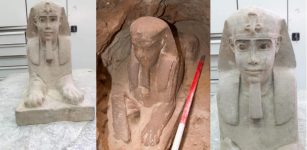Riddle Of Two Undeciphered Elamite Scripts
A. Sutherland - AncientPages.com - The Proto-Elamite script is the world's oldest system of writing that has yet to be deciphered. This Early Bronze Age writing was briefly in use before the introduction of Elamite cuneiform.
Susa III/ Proto-Elamite cylinder seal with bulls and lion, 3100-2900 BC, Louvre Museum, reference Sb 6166. Source
Later, Elamite cuneiform was adapted from Akkadian Cuneiform and used from c. 2500 to 331 BC. It consisted of roughly 130 glyphs and only a few logograms from Akkadian. Over time, the number of logograms increased, and the writing consists of about 20,000 tablets and fragments. Most of them belong to the Achaemenid Era (730 – 330 BC) and contain mainly financial records.
The Proto-Elamite script consists of about 1,000 signs and is therefore thought to be partly logographic (with written characters representing a word or a small meaning).
The name "Proto-Elamite" refers to a writing system in use in the Susa plain and the Iranian highlands located east of Mesopotamia (ca. 3100 (3050) and 2900 (2700) B.C., a period generally believed to correspond to the Uruk III /Jamdat Nasr through Early Dynastic I periods in Mesopotamia.
Economic tablet in Proto-Elamite, Suse III, Louvre Museum, reference Sb 15200, circa 3100-2850 BC. Image source - Mbzt - CC BY 3.0
Proto-Elamite tablets represent the earliest complex written documents from the region. The script consists of numerical and ideographic signs, and the latter sometimes assumed to represent a genetically related forerunner of the Old Elamite language. However, this supposed forerunner language is unknown, and the script itself has been only partially deciphered.
The Proto-Elamite script is thought to have been developed from early Sumerian writing. It was used over a vast geographical area, stretching from the ancient city of Susa in the west, to Tepe Yahya in the east, and perhaps even beyond. The knowledge about this language comes from approximately 1600 existing tablets, and most of them were unearthed at Susa.
The very old are also early cuneiform writing and hieroglyphics; however, if we think of mental work needed to read the Elamite scripts, generally, it is more challenging than reading the hieroglyphics.
Francois Desset And Linear Elamite Script
The linear Elamite script was used in the kingdom of Elam for several centuries, between the end of the third and the beginning of the second millennium B.C.
Not long ago, more precisely in 2020, Francois Desset of the Laboratoire Archeorient in Lyon, France, announced a decipherment and translation of a Linear Elamite script - phonetic writing of cuneiform type used 4,400 years ago in what is now Iran.
Multiple clay tablets covered with this handwriting were first unearthed in the ancient ruins of Susa in 1901. For the last 120 years, linguists could not decipher and eventually fully understand what was written more than four millennia ago.
Until today, the proto-cuneiform script from Mesopotamia dated to around 3300 BC.was considered the oldest example of writing.
However, reading the Linear Elamite script makes us change our view on this subject. Now, it is known that in parallel, around 2300 BC, according to Desset, another system of writing was emerging, and its oldest version (proto-Elamite script), maybe as ancient as the oldest Mesopotamian proto-cuneiform tablets.
In short, the first does not constitute a "mother writing" of which the proto-Elamite would be the daughter. In reality, they are like "two sisters."
 Economic tablet with numeric signs and Proto-Elamite script. Clay accounting tokens, Uruk period. From the Tell of the Acropolis in Susa. Image source - Marie-Lan Nguyen - CC BY 2.5
Economic tablet with numeric signs and Proto-Elamite script. Clay accounting tokens, Uruk period. From the Tell of the Acropolis in Susa. Image source - Marie-Lan Nguyen - CC BY 2.5
Desset concludes that the script did not first appear in Mesopotamia and later in the region of present-day Iran. Instead, these two writing systems (Mesopotamian Proto – Cuneiform and Iran's Proto-Elamite) existed in parallel. It was the same writing system that evolved and was recorded differently in different historical periods.
It is an important discovery (Desset's work still awaits a scientific review) that significantly changes our view of the development of the script. We even have to reconsider all the consequences associated with it.
The Linear Elamite script is different from the cuneiform script, a combination of phonograms, which are signs for identifying sounds, with logograms (signs for identifying things, words, or ideas). Linear Elamite writing, on the other hand, is phonetic writing. Individual characters mean syllables, consonants, and vowels. It was, along with proto-Elamite writing, used from about 3300 to about 1900 B.C. At this time, there was a significant evolution of this writing.
For now, it is uncertain whether the Proto-Elamite script was the direct forerunner of Linear Elamite.
Both scripts remain undeciphered. A clear relationship between these two old languages is not proved but can only be speculated.
Written by – A. Sutherland - AncientPages.com Senior Staff Writer
Copyright © AncientPages.com All rights reserved. This material may not be published, broadcast, rewritten or redistributed in whole or part without the express written permission of AncientPages.com
Expand for referencesMore From Ancient Pages
-
 Strange History Of Safety Coffins: From Ancient To Modern Times
Featured Stories | Feb 9, 2016
Strange History Of Safety Coffins: From Ancient To Modern Times
Featured Stories | Feb 9, 2016 -
 Legendary And Mysterious Stone Of Brutus – The London Stone Refuses To Give Up Its Secrets
Artifacts | Jan 21, 2022
Legendary And Mysterious Stone Of Brutus – The London Stone Refuses To Give Up Its Secrets
Artifacts | Jan 21, 2022 -
 Sandstone Statue Of A Sphinx Discovered In Kom Ombo Temple
Archaeology | Sep 18, 2018
Sandstone Statue Of A Sphinx Discovered In Kom Ombo Temple
Archaeology | Sep 18, 2018 -
 Did A Universal Ancient Civilization Give Birth To All Other Cultures Across The World?
Civilizations | May 4, 2021
Did A Universal Ancient Civilization Give Birth To All Other Cultures Across The World?
Civilizations | May 4, 2021 -
 One Of The Oldest Manuscripts Fragments Of The Famous Merlin Legend Discovered
Archaeology | Sep 2, 2021
One Of The Oldest Manuscripts Fragments Of The Famous Merlin Legend Discovered
Archaeology | Sep 2, 2021 -
 A Scientific Surprise: Bering Land Bridge Formed Late During Last Ice Age
Archaeology | Dec 27, 2022
A Scientific Surprise: Bering Land Bridge Formed Late During Last Ice Age
Archaeology | Dec 27, 2022 -
 Sacred Crystals Of The Cherokee – Myths, Traditions And History Explained
Featured Stories | Jun 3, 2019
Sacred Crystals Of The Cherokee – Myths, Traditions And History Explained
Featured Stories | Jun 3, 2019 -
 Puzzling Huge Ancient Sayhuite Monolith In Peru Remains An Unsolved Mystery
Civilizations | Jul 23, 2016
Puzzling Huge Ancient Sayhuite Monolith In Peru Remains An Unsolved Mystery
Civilizations | Jul 23, 2016 -
 Previously Unseen Creature Emerges From Restored Joshua Reynolds Painting
Scripts, Paintings & Inscriptions | Nov 17, 2023
Previously Unseen Creature Emerges From Restored Joshua Reynolds Painting
Scripts, Paintings & Inscriptions | Nov 17, 2023 -
 Late Neolithic Italians Mastered Complex Metal Technologies – New Study
Archaeology | Jan 22, 2020
Late Neolithic Italians Mastered Complex Metal Technologies – New Study
Archaeology | Jan 22, 2020 -
 Tantalus – Greek King And Evildoer Who Violated Divine Laws And Was Sent To Tartarus
Featured Stories | Mar 1, 2019
Tantalus – Greek King And Evildoer Who Violated Divine Laws And Was Sent To Tartarus
Featured Stories | Mar 1, 2019 -
 Dingoes Given ‘Almost-Human’ Status In Pre-Colonial Australia – Archaeological Study Finds
Archaeology | Oct 21, 2023
Dingoes Given ‘Almost-Human’ Status In Pre-Colonial Australia – Archaeological Study Finds
Archaeology | Oct 21, 2023 -
 On This Day In History: Chinese General Koxinga Seizes The Island Of Taiwan – On Feb 1, 1662
News | Feb 1, 2017
On This Day In History: Chinese General Koxinga Seizes The Island Of Taiwan – On Feb 1, 1662
News | Feb 1, 2017 -
 Late Roman-Era Rooms, Offering Vessels Unearthed At Ancient City Of Antiocheia, Southern Türkiye
Archaeology | Oct 31, 2022
Late Roman-Era Rooms, Offering Vessels Unearthed At Ancient City Of Antiocheia, Southern Türkiye
Archaeology | Oct 31, 2022 -
 Fomorians: Supernatural Race Of Giants Who Came From Atlantis
Celtic Mythology | Jul 18, 2017
Fomorians: Supernatural Race Of Giants Who Came From Atlantis
Celtic Mythology | Jul 18, 2017 -
 Winged Hussars: Facts And History About The Polish Warriors, Their Armor And Military Tactics
Featured Stories | Feb 14, 2016
Winged Hussars: Facts And History About The Polish Warriors, Their Armor And Military Tactics
Featured Stories | Feb 14, 2016 -
 Surprising Discovery Of Ancient Sarcophagus At Paris’ Notre Dame Cathedral
Archaeology | Mar 16, 2022
Surprising Discovery Of Ancient Sarcophagus At Paris’ Notre Dame Cathedral
Archaeology | Mar 16, 2022 -
 Ancient Maya: Wealth Inequality And Despotism That Governed The Society
Archaeology | Mar 26, 2021
Ancient Maya: Wealth Inequality And Despotism That Governed The Society
Archaeology | Mar 26, 2021 -
 Ancient Pottery Reveal How Peru’s First Great Empire Wari Functioned
Archaeology | Mar 14, 2023
Ancient Pottery Reveal How Peru’s First Great Empire Wari Functioned
Archaeology | Mar 14, 2023 -
 Strange Mythical Creature Resembling A Sphinx Discovered In A Medieval Bathroom
Archaeology | Mar 10, 2020
Strange Mythical Creature Resembling A Sphinx Discovered In A Medieval Bathroom
Archaeology | Mar 10, 2020



